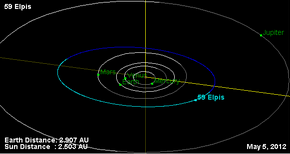 Orbital diagram Orbital diagram | |
| Discovery | |
|---|---|
| Discovered by | Jean Chacornac |
| Discovery date | September 12, 1860 |
| Designations | |
| MPC designation | (59) Elpis |
| Pronunciation | /ˈɛlpɪs/ |
| Named after | Elpis |
| Minor planet category | Main belt |
| Adjectives | Elpidian /ɛlˈpɪdiən/ |
| Orbital characteristics | |
| Epoch December 31, 2006 (JD 2454100.5) | |
| Aphelion | 453.624 Gm (3.032 AU) |
| Perihelion | 358.808 Gm (2.398 AU) |
| Semi-major axis | 406.216 Gm (2.715 AU) |
| Eccentricity | 0.117 |
| Orbital period (sidereal) | 1634.355 d (4.47 a) |
| Mean anomaly | 246.848° |
| Inclination | 8.631° |
| Longitude of ascending node | 170.209° |
| Argument of perihelion | 210.901° |
| Physical characteristics | |
| Dimensions | 164.8±6.0 km |
| Mass | (3.00±0.50)×10 kg |
| Mean density | 1.30±0.26 g/cm |
| Synodic rotation period | 13.69 h |
| Geometric albedo | 0.044 |
| Spectral type | CP/B |
| Absolute magnitude (H) | 7.93 |
59 Elpis is a large main belt asteroid that orbits the Sun with a period of 4.47 years. It is a C-type asteroid, meaning that it is very dark and carbonaceous in composition. In the Tholen scheme it has a classification of CP, while Bus and Binzen class it as type B.
Elpis was discovered by Jean Chacornac from Paris, on September 12, 1860. It was Chacornac's sixth and final asteroid discovery.
A controversy arose over the naming of Elpis. Urbain Le Verrier, director of the Paris Observatory, at first refused to allow Chacornac to name the object, because Leverrier was promoting a plan to reorganize asteroid nomenclature by naming them after their discoverers, rather than mythological figures. A protest arose among astronomers. At the Vienna Observatory, Edmund Weiss, who had been studying the asteroid, asked the observatory's director, Karl L. Littrow, to name it. Littrow chose Elpis, a Greek personification of hope, in reference to the favorable political conditions in Europe at the time. In 1862, Leverrier permitted Chacornac to choose a name, and he selected "Olympia" at the suggestion of John Russell Hind. However, Elpis is the name that stuck.
Elpis has been studied by radar.
References
- The Century Dictionary and Cyclopedia, under "Schwartz, Madame von"
- E.g.American ecclesiastical review, v. 21 (1899)
- ^ "JPL Small-Body Database Browser: 59 Elpis" (2011-09-01 last obs). Jet Propulsion Laboratory. Retrieved 26 January 2012.
- ^ Carry, B. (December 2012), "Density of asteroids", Planetary and Space Science, 73 (1): 98–118, arXiv:1203.4336, Bibcode:2012P&SS...73...98C, doi:10.1016/j.pss.2012.03.009. See Table 1.
- Asteroid Data Sets Archived 2009-12-17 at the Wayback Machine
- Rivkin, A. S.; et al. (September 2003), "Hydrogen concentrations on C-class asteroids derived from remote sensing", Meteoritics & Planetary Science, 38 (9): 1383–1398, Bibcode:2003M&PS...38.1383R, doi:10.1111/j.1945-5100.2003.tb00321.x.
- Appletons' annual cyclopaedia and register of important events of the year: 1862. New York: D. Appleton & Company. 1863. p. 173.
- Schmadel, Lutz D. (2003). Dictionary of Minor Planet Names. Springer Science & Business Media. pp. 20–1. ISBN 978-3-540-00238-3.
- "Radar-Detected Asteroids and Comets". NASA/JPL Asteroid Radar Research. Retrieved 26 January 2012.
External links
- 59 Elpis at AstDyS-2, Asteroids—Dynamic Site
- 59 Elpis at the JPL Small-Body Database

| Minor planets navigator | |
|---|---|
| Small Solar System bodies | |||||||
|---|---|---|---|---|---|---|---|
| Minor planets |
| ||||||
| Comets | |||||||
| Other | |||||||
This article about a C-type asteroid native to the asteroid belt is a stub. You can help Misplaced Pages by expanding it. |